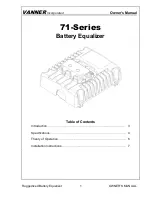
Introduction
The NOLAN Wireless Stereo Receiver / Headset offers the latest
innovation in Bluetooth technology. It wirelessly receives stereo
audio sound ** from a Bluetooth mobile phone, MP3 player,
Bluetooth stereo player or a Bluetooth enabled PC with suitable
software.
** Compatible stereo Bluetooth devices must support the
Bluetooth profile known as ‘Advanced Audio Distribution Profile
(A2DP)’
The Wireless Stereo Receiver/headset is also capable of
simultaneous connection to a Bluetooth enabled mobile phone
using Headset or Handsfree profile. You need never miss a call
while enjoying your music wirelessly.
Getting Started
Remove all components from the package. Items in the pack include:
Stereo Receiver, Stereo earpiece, USB Charging cable, and this
User Guide. Please check the contents carefully and contact your
local dealer immediately if anything is missing or damaged
.
Getting to Know Your Receiver/Headset
See image above. Please note some models of headset will differ
slightly in style, colour and the functionality may vary according to
their specifications. For uptodate information check the support
section of the NolaN web site: www.nolansys.com
Charging Your Receiver/Headset
Before using the Receiver/headset, you must charge it for
approximately 2 hours. Fully charged, it can provide up to 5 hours of
playing time and 100 hours of standby time.
Please note that talk time is also a function of the player/mobile
phone and their factory determined settings. So, you may find
this figure is reduced under certain conditions.
To charge the receiver/headset
1. Insert the mini USB plug of the charging cable into the mini USB
charger socket on the receiver/headset.
2. Insert the USB plug on the other end of the USB charging cable
into a powered USB socket on a PC or laptop computer. During
charging, the amber LED will be on constantly.
3. When charging is complete, the amber LED will turn off.
4. Unplug the USB charging cable.
Battery Indication:
The amber LED can turn off after less than 2
hours charging; this normally indicates that the receiver/headset can
be used.
However, for the initial charge, it is recommended that you
charge the receiver/headset for at least 2 hours in order to fully
prepare the battery for normal operation
.
Hold/Unhold switch.
This switch prevents unwanted button presses
during playing. Ensure you slide it away from the ‘HOLD’ label before
attempting to operate the receiver.
Pairing Your Receiver/Headset with a Stereo Player
Pairing is the Bluetooth process of initialising the wireless link
between the headset and a Bluetooth mobile phone**, a Bluetooth
stereo player** or a Bluetoothenabled PC**. Before you can use the
receiver/headset you must pair it with one of these devices. Normally
you only have to do this once. After pairing is complete the units will
(provided they are within range) find each other and reconnect
automatically at switch on.
Important Note (1): The receiver/headset will only pair
automatically with players that have the builtin PIN code: ‘0000’
To pair your Receiver/Headset with a Stereo Player
1.
Before you commence pairing please ensure that both units are
fully charged.
2.
Ensure that no other nearby Bluetooth devices are active or in
pairing mode.
3.
Make sure the phone or player supports the Bluetooth A2DP
profile. (For Bluetoothenabled PCs or Notebooks you must
have a Bluetooth driver which supports the A2DP profile.)
4.
To turn on the receiver/headset press and hold the Talk button
for about 2 seconds until both the blue and amber LEDs begin
to flash alternately. The receiver/headset is now turned on and
in pairing mode.
5.
Ensure the receiver/headset is within 10 metres of the stereo
player, mobile phone, PC or laptop.
6.
Initiate device discovery feature on the player. Refer to your
player’s User Guide if you are not sure how to do this.
7.
The player should find the receiver/headset and pair with it.
This is indicated by the LEDs on the receiver/headset. The
amber LED will stop flashing and the blue LED will begin to
flash slowly (approx once every two seconds).
To pair your Receiver/Headset with a Mobile Phone or PC/Laptop
for stereo audio playing.
(Please check the phone or PC software User Guide for details)
1.
Complete steps 1 through 5 above
2.
Initiate the device discovery feature on the player. Refer to
your player’s User Guide if you are not sure how to do this.
3.
The phone or PC should find the headset and display its
Bluetooth name ‘BTSHS’. Select this device.
4.
When prompted by PC or phone, enter default pin code ‘0000’.
5.
When pairing is complete the amber LED will stop flashing and
the blue LED will begin to flash slowly (approx once every two
seconds).
To cancel pairing mode
While the receiver/headset is in pairing
mode, you can cancel the pairing process and turn off the
receiver/headset. Press and hold the Talk button for about 3
seconds. The Blue LED will switch on for about 1 second and then
the receiver/headset will turn off. Release the Talk button.
Pairing Tips:
+ Please refer to your phone or player’s user manual for further
information on ‘How to Pair’. Typically, you need to make your
phone ‘Discover’ the receiver/headset by using a ‘Bluetooth’,
‘Connect’ or ‘Setup’ menu then selecting an option to ‘Discover’
your receiver/headset
.
+ The receiver/headset, in normal operation, should maintain a link
with the player at all times once pairing has been successful and
a connection has been established between the two devices.
+ If you find that you cannot put the receiver/headset into pairing
mode then try temporarily switching off (or disabling Bluetooth on)
the last player or device used with the receiver/headset.
BLUETOOTH
STEREO
RECEIVER/HEADSET
P/N NSRXRM3C2XXX
Declaration of Conformity
.
We declare that product NSRXRM3C2XXX conforms to
the R&TTE Directive 1999/5/EC




















